3 min read
Patient tracking in an emergency using HIPAA compliant text messaging
Kirsten Peremore
June 12, 2024
With instant and secure communication channels, medical teams can swiftly exchange updates about patients' whereabouts, conditions, and necessary treatments. HIPAA compliant text messaging offers a secure and accessible method of communicating during distress situations that do not require the Internet.
The use of patient tracking during emergency responses
When a crisis strikes—be it a natural disaster, a major accident, or a public health emergency—the need for an immediate and effective emergency response springs into action.
A collaborative study released by UC Berkley provided the following on the purpose of information during an emergency, “A practical way to improve the execution of emergency response activities is to provide response coordinators with real time information that facilitates immediate assessment of the scope of a disaster. This information can be used to determine how resources should best be allocated in order to save as many lives as possible.”
These are moments when every second counts and the complexities of providing patient care escalate dramatically. Challenges such as overwhelmed facilities disrupted communication networks, and the urgent necessity for rapid decision making can make delivering timely care daunting.
In these high stress scenarios, patient tracking becomes an indispensable tool. It allows healthcare providers to swiftly identify, locate, and monitor the status of each patient. With a patient tracking system, healthcare teams can dramatically reduce response times and avoid the chaos often associated with such emergencies. This coordination is not just about managing logistics; it's about saving lives. Effective patient tracking directly translates into enhanced patient safety and improved health outcomes.
See also: How does HIPAA define an emergency?
The basic components of effective patient tracking
Several components work together to make sure that patient tracking remains consistent and effective. The basic components include:
- An effective patient tracking system starts with a reliable method to identify patients. Each patient is assigned a unique identifier, which helps in tracking their location, status, and medical needs throughout the emergency response.
- Tools such as handheld devices, tablets, or mobile apps for entering and accessing patient information on the go. These tools should be easy to use, fast, and capable of working offline or in low connectivity environments.
- A centralized database for storing all patient data collected during an emergency. This database should be secure, easily accessible to authorized personnel, and capable of handling large volumes of data without performance issues.
- The ability to update patient information in real time and communicate changes to all relevant parties is vital.
- The system should be interoperable with other health information systems. This ensures that data can be seamlessly shared across different platforms and organizations, facilitating a coordinated response among various emergency services, hospitals, and care providers.
How can HIPAA compliant text messaging be used for patient tracking in emergencies?
- Develop a protocol for assigning a unique identifier to each patient upon their entry into the emergency response system. This could be a combination of letters and numbers that does not reveal personally identifiable information.
- Implement identification tools, such as bracelets or cards, that can be scanned or entered manually into handheld devices to record and track patient data.
- Select appropriate devices like smartphones, tablets, or specialized handheld devices that can be used to enter and access patient information. Ensure these devices are equipped with secure, HIPAA compliant messaging apps or software.
- Preload devices with necessary software that can operate reliably offline or in low connectivity environments, ensuring continuous operation during various emergency scenarios.
- Create or integrate with a secure, centralized database that can store all patient tracking information. This database should be encrypted, backed up regularly, and should comply with HIPAA regulations.
- Ensure database accessibility to authorized personnel only, with secure login and authentication systems in place to prevent unauthorized access.
- Configure the text messaging system to send notifications to medical staff and emergency responders whenever there are updates to a patient's location, status, or medical needs.
- Develop a protocol for regular updates using the text messaging system, ensuring all parties involved in the care and response are informed in real time.
- Ensure the text messaging platform is interoperable with other health information systems used by hospitals, emergency services, and other care providers. This may involve using standard data exchange formats and protocols like HL7 or FHIR.
- Develop clear, accessible user manuals or quick reference guides that staff can refer to in an emergency, ensuring they are familiar with the system’s functionalities and protocols.
See also: What is a public health emergency?
FAQs
How do patients opt in or consent to being tracked via text messaging during emergencies?
Patients typically provide consent through standard intake forms or specific emergency consent forms that include provisions for text message tracking.
Can these systems be used for routine medical communication outside of emergencies?
Yes, it can also be used for appointment reminders and health updates.
What alternatives are available if a healthcare organization chooses not to use text messaging for patient tracking?
Alternatives include using email systems, specialized patient tracking software, or integrated healthcare platforms that comply with HIPAA.
Subscribe to Paubox Weekly
Every Friday we'll bring you the most important news from Paubox. Our aim is to make you smarter, faster.



